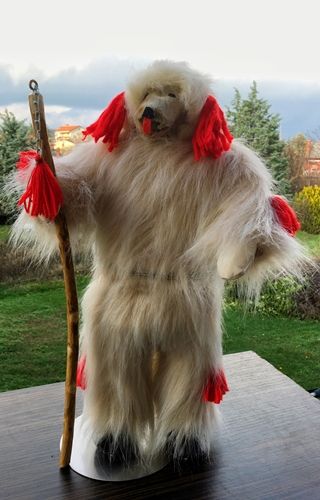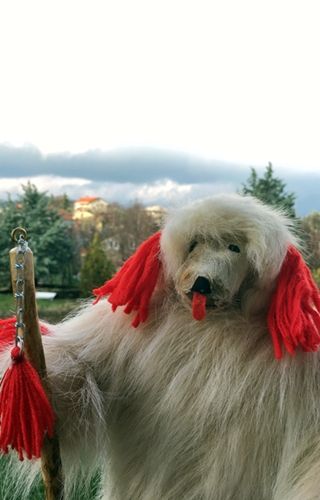ARAPIDES (Drama)
“Arapides” (Blacks) January 6
The cast of the performance-“dromeno”, called the “tseta”, consists of “Arapides” (Blacks), “Gilliges”, “Papoudes” (grandparents) and “Tsoliades”. The “Arapides” wear black pastoral cloaks that cover the entire body and impressive peaked goatskin head masks. On their waist they place three large bells, “batali” (large bells) or “kypri” (smaller bells, local name “tsianouve”), which are harmonically matched. They also hold a large wooden sword and a small bag of ashes, which they gathered during the Twelve Days of Christmas. umes.
The “tseta” is accompanied by instrumentalists of local traditional musical instruments, the Macedonian lyra and the “dahare” (a type of a frame drum).
DJALAMARI ( Kavadarci )
The traditional mask "Djalamari" is made of a large hooded robe 8 nametak) hand made from goat hair. Their face is blackened with soot and hidden behind a fake mustache and beard made of sheepskin. Some of them wear big round tin bells while others wear smaller cone shaped brass bells. Black pants, white woolen socks and shoes ensure that they stay warm even in the winter months. That is the time when "Djalamari" using their appearance, a wooden cane and the racket of their bells drive off evil spirits from the homes of their hosts.
This old tradition is held every year on January 13th and 14th which is also te time of their carnival (Sopotski karneval).
GEROI & KORELA (Skyros)
The characters that dominate the carnival of Skyros are those of the “Geros”, the “Korela” and the “Frangos”. The “Geros” wears the typical woolen cape of shepherds turned upside down, with the hairy side outward, an element that in conjunction with the mask made of small animal´s pelt that covers the face, gives him a distinct ferocity. The hood of the cape, fastened with a belt, covers the head, and the costume is completed with woollen pants (“kontovratsi”), white woven socks and typical shepherd´s leather sandals, called “trochadia”. In his back he puts rags or an old pillow that gives the impression of a hump. On one hand he holds a wooden curved shepherd´s stick and on the other a bag with flour or bran, necessary for his encounter with the people on the way to the square. But what spreads fear and awe in his passage is the sound of 50-60 bells that are fastened with wooden hoops placed through a rope, the “litari”, to hang freely and thunder as he moves rhythmically through the narrow streets of the island. The interpretations of the origins of this masquerade vary. Legend has it that a reckless shepherd appeared in the village square, dressed in animal pelts that perished in heavy winter, loaded with the bells of the flock and accompanied by his wife dressed in rags.
Most likely, however, is the interpretation that its roots go deeper than that and are associated with Dionysian fertility rituals.
JENITSAROS (Naoussa)
Each year, Naoussa, a Greek city hero in Central Macedonia celebrates the carnival. Dying in her traditional costumes, „Jenitsaros“ celebrates an ancient ritual that takes place in three phases. Morning is the time of wearing a complex layered costume in front of the whole family, which can take several hours. The second stage takes place in front of the city hall where all the dance groups come and ask the mayor permission to start the procession. The dancers start the ritual in the morning accompanied by the players on traditional instruments and end in the evening. "For us dancers, it's almost a magical event. Sometimes we feel like someone else takes us," they say. You can hardly see anything through the small openings on the mask, wear a costume of up to 25 kilos, and the costume of Jenitsaros is heavy and uncomfortable. However, today there are many dance groups that participate in this procession every year. By the time of sunset, all groups meet in the final phase of Alonion Square. In the houses on the square people stand on the balconies sharing this moment of joy. The doors are open, as in old times. In the evening everything ends with street fun when everyone emotionally greets them with tears in the eye. Some believe that the origins of this carnival tradition are inspired by Turkish occupation, in which Naoussa gained the title "heroic city".
Others say that they are pagan spring rituals, while others believe that the ritual has to do with the mythological immortality of Alexander the Great.
KUKERI (Yambol)
(Bulgarian: кукери; singular: kuker, кукер)
are elaborately costumed Bulgarian men who perform traditional rituals intended to scare away evil spirits. Closely related traditions are found throughout the Balkans and Greece (including Romania and the Pontus). The costumes cover most of the body and include decorated wooden masks of animals (sometimes double-faced) and large bells attached to the belt. Around New Year and before Lent the kukeri walk and dance through villages to scare away evil spirits with their costumes and the sound of their bells. They are also believed to provide a good harvest, health, and happiness to the village during the year. The kukeri traditionally visit peoples' houses at night so that "the sun would not catch them on the road. After parading around the village they usually gather at the village square to dance wildly and amuse the people.
Kukeri rituals vary by region but remain largely the same in essence.
SURVAKARI (Pernik)
Survakari are masked dancers who wear coats made of goat skin or “tatters” and pointed hats around six feet high. They have large bells tied around their waists which clang loudly as they move. They carry wooden swords and a decorated cornel twig called a sourvachka. They “appear” in Breznik and Radomir Districts, Shopluk Region around the time of New Year’s Eve, travel in groups of seven or nine dancers from house to house and bring with them wishes for good health. They are followed by various characters such as “gods”, clowns, a physician, a bride, or animals.
When two groups meet they often fight a “mock” battle. This custom is of Slav origin.
URSU (Bogdanešti)
In the northeastern part of Romania, in the historic part of Moldova, on the border with Ukraine, there is a picturesque Monastery of Bogdanište from the 14th century, with its place of the same name. On the last day of the year, at the "Bear Festival", numerous folklore groups and guardians of tradition from all over the country are gathered in the spectacular bear fairy, ending and culminating with the "bear" dance on the main square in front of thousands of thrilled spectators. Ursu is mostly found in Moldavia today, but similar traditions have origins throughout the country.
Romania still has the largest number of brown bear in Europe living freely in the mountains, and the ever-present human desire to conquer wild animals, the largest and the strongest bear bearer, is certainly the reason for this tradition.




























